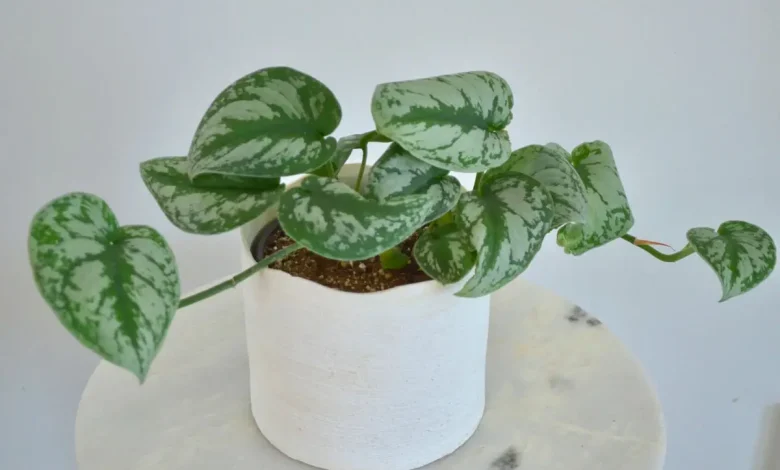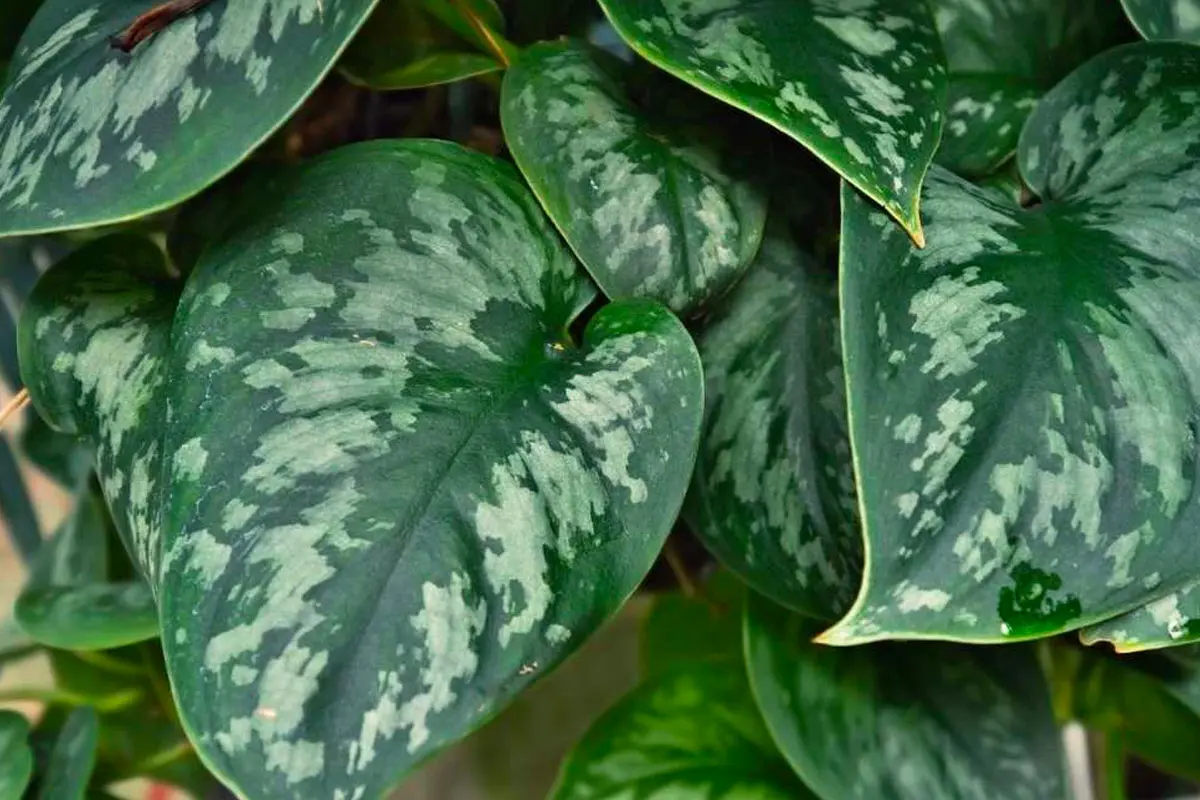How to Take Care of Satin Pothos

With its elegant trailing vines and distinctive silver-splashed leaves, satin pothos makes a popular houseplant known for its low maintenance nature. However, there are still important care needs to understand to keep this beauty looking its best. Read on to learn more about caring for satin pothos.
About Satin Pothos
Satin pothos, or Scindapsus pictus, is a trailing vine in the pothos family. It has shiny, satiny heart-shaped leaves with silver variegation that emerge from green stems. Given proper support, the vines can grow up to 10 feet long. Easy to grow, satin pothos cascades beautifully from containers. The leaves are smaller than golden pothos but larger than jade pothos leaves.
Natural Habitat
In the wild, satin pothos is native to the Solomon Islands located in the South Pacific. It thrives in the warm, humid rainforests and jungles of the region. Satin pothos favors an environment rich in organic material and moisture. It often grows as an understory plant in shaded areas of the jungle floor.
Unique Features
What makes satin pothos special? Some standout qualities include:
- Trailing vines with heart-shaped silver and green variegated leaves
- Tolerates low light well compared to other houseplants
- Quick growing and easy propagation from cuttings
- Cascades beautifully from hanging pots and containers
- Unfussy, easygoing nature perfect for beginners
- Lush, full foliage with proper care and conditions
Caring For Satin Pothos
While satin pothos is flexible and easygoing, provide the following care for the healthiest, most vigorous growth:
Light Requirements
Satin pothos grows well in low to moderate light conditions but prefers bright, indirect sunlight for fullest growth. Some early morning sun or late afternoon sun is beneficial but avoid prolonged hot, direct midday sun which can scorch the foliage. Insufficient light leads to sparse, leggy growth. Rotate the plant periodically to encourage even growth on all sides.
Watering
Allow the top inch or two of soil to dry out between waterings. Check by inserting your finger in the soil to gauge moisture levels. Water less frequently in winter when growth naturally slows. Signs of under-watering include drooping, yellowing leaves and a wilted appearance. Be careful not to overwater, as soggy soil can lead to root rot. Ensure the container has adequate drainage holes to prevent waterlogged soil.
Humidity
Average indoor humidity is fine for satin pothos, but higher humidity is appreciated. Ideal levels are 40% humidity or above. Use pebble trays filled with water, indoor humidifiers, or frequent misting of the foliage to help boost moisture levels around your plant.
Soil
Use a well-draining, light potting mix rather than heavy garden soil which stays too wet. A good quality potting soil amended with compost or peat moss to help retain some moisture is ideal. Re-pot every few years to refresh the soil and provide room for root growth.
Fertilizer
Fertilize monthly through the active growing period of spring through summer. Use a balanced liquid houseplant fertilizer diluted to half strength. Reduce fertilizer applications in fall and winter when growth naturally slows. Rinse the leaves after fertilizing to avoid burn.
Pruning
Pinch back or prune long, leggy stems to encourage bushier, fuller growth. Pruning can be done anytime but is especially helpful in early spring. Prune back to just above a leaf node so new shoots can emerge. Remove any dead or damaged growth as needed.
Pest Control
Inspect the undersides of leaves and stems regularly for pests like spider mites, mealybugs, and scale. These sap-sucking insects can thrive in the warm, humid conditions satin pothos enjoys. Wipe leaves with a damp cloth to help remove pests. Neem oil, insecticidal soap or horticultural oils can also be sprayed to treat infestations. Isolate heavily infested plants to prevent spreading.

Promoting Growth
Maximize satin pothos growth and vitality with:
Achieving Fuller Foliage
Provide warm temperatures between 65-80°F, bright indirect sunlight, adequate hydration, and monthly fertilizer to achieve full, lush satin pothos growth. High humidity also benefits the foliage. Rotate the plant and prune back wayward vines to inspire bushier, more compact growth. Propagate satin pothos often by taking stem cuttings and potting them up to establish new plants. This allows you to fill out a planting for a fuller appearance.
Troubleshooting Problems
Dropping leaves, leggy sparse growth, browning leaf tips, and pest issues often result from improper conditions. Adjust your watering frequency and volume, light levels, humidity, ventilation, temperatures, and fertilizer regimen to resolve any problems. Disinfect pruning shears and isolate affected plants from healthy ones if disease is suspected.
Care Tips
Follow these tips for beautiful, healthy satin pothos:
- Provide bright, indirect sunlight avoiding direct hot sun
- Water thoroughly only when the top inch of soil becomes dry
- Use pebble trays, humidifiers, and misting for 40% humidity
- Prune back extra long vines to stimulate bushier growth
- Fertilize monthly with a balanced houseplant food
- Propagate new plants from stem cuttings often
- Monitor closely for pests like spider mites under leaves
- Rotate the plant to encourage even growth on all sides
- Re-pot every few years into fresh potting mix
Propagation
Satin pothos is very easy to propagate from stem cuttings. Other methods can also be used:
By Stem Cuttings
The easiest propagation method is by stem cuttings. Choose a healthy stem that is 4-6 inches long and cut it just below a leaf node using sterilized scissors. Remove the bottom set of leaves and place the cutting in a glass of water or into a potting mix like peat and perlite. Roots should emerge in 3-6 weeks. Once rooted, pot up the new plant in regular potting soil. Keep it well-watered while it establishes. The water method lets you watch the rooting process.
By Other Methods
Satin pothos can also propagate by layering long vines that touch the ground. Simply pin a section to the soil and it will form new roots. The vine section can then be severed and replanted. Division of the rhizome is another way to get new plants that are exact clones of the parent.
Displaying Satin Pothos
One of the best ways to show off a satin pothos is by letting it trail gracefully from high shelves, hanging baskets, or wall mountings. The vines can be trimmed back regularly to control the length. Satin pothos also looks beautiful climbing up a support. Provide a trellis, pole, or walls for the vines to climb and wind around. Rotate the plant and prune back some stems to encourage full, bushy growth on all sides rather than just growing in one direction.
Tips for Keeping Satin Pothos Healthy
Here are some key tips to remember when caring for satin pothos:
- Place in a bright location with indirect sun to encourage full growth
- Water thoroughly only when the top 1-2 inches of soil become dry
- Use pebble trays and misting to boost humidity levels around the plant
- Prune back extra long vines to control size and promote bushiness
- Feed monthly with a balanced liquid fertilizer in spring and summer
- Check new growth for pests like spider mites which thrive in warmth and humidity
- Propagate by stem cuttings often for fuller plantings
- Repot every few years into fresh, well-draining potting mix
- Rotate the plant to promote even growth on all sides

Conclusion
Enjoying Satin Pothos
With its lush silver-splashed heart-shaped leaves trailing gracefully or climbing upwards, satin pothos provides elegant easy care appeal. Give it bright filtered light and occasional watering when the top soil dries and this unfussy vine will thrive indoors for many years. Mist it often, keep temperatures warm, and propagate it frequently for endless full foliage.
FAQ
How much light does satin pothos need?
Satin pothos grows well in low to moderate light but prefers bright, indirect sunlight for several hours a day. Some early morning or late sun is beneficial. Insufficient light causes sparse, leggy growth.
What temperatures are best for satin pothos?
Satin pothos thrives in average household temperatures between 65-80°F.
What causes leggy or sparse growth in satin pothos?
The most common cause of leggy, sparse growth in satin pothos is insufficient light exposure. Try moving the plant to a brighter location with more indirect sunlight. Slowly increase light levels over time to avoid shocking or burning the foliage. Rotate the plant periodically for even exposure.
How can I get my satin pothos to grow fuller?
To promote fuller, bushier growth, provide bright indirect light, warm temperatures, adequate water and humidity, monthly fertilizer, and frequent pruning. Propagating new plants from cuttings and filling out plantings creates a lush, full look.
When is the best time to repot a satin pothos?
The best time to repot a satin pothos is in early spring before the main growing season begins. This gives the roots time to establish in the new potting mix. Repot every 2-3 years or whenever the roots have filled the container.
Should I prune my satin pothos?
Yes, pruning is beneficial for satin pothos. It encourages bushier, compact growth rather than leggy vines. Prune back trailing stems above a leaf node. Remove any dead or damaged growth as needed. Pinching stems promotes branching.
How do I treat pest problems on my satin pothos?
Check for pests like spider mites and mealybugs, especially under leaves. Wipe with a wet cloth or use horticultural oil, insecticidal soap or neem oil sprays. Remove severely infested foliage. Isolate plants and discard badly infested ones.
Why are the leaf tips brown on my satin pothos?
Brown leaf tips are often caused by dry air. Increase humidity through misting, pebble trays, or humidifiers. Low humidity leads to leaf tip browning. Over-fertilizing and inconsistent watering can also cause this issue.
How do I revive a limp satin pothos?
A limp, wilting satin pothos usually indicates under-watering. Water the plant thoroughly and allow excess water to drain fully. Provide bright indirect light and humidity. Remove any dead growth. The plant should perk up within a few days once properly hydrated.
Can I grow satin pothos outdoors?
Satin pothos is an indoor plant but can be placed outside temporarily in warm weather. Bring indoors if temperatures drop below 60°F. Avoid direct hot sun which can scorch the leaves. Hardening off is required when moving between indoor and outdoor.
Is satin pothos toxic to pets?
Yes, satin pothos is toxic to dogs, cats, and other pets if leaves or stems are chewed or ingested. It contains insoluble calcium oxalates that can cause oral irritation, swelling, and drooling if eaten. Keep satin pothos out of reach of pets.







